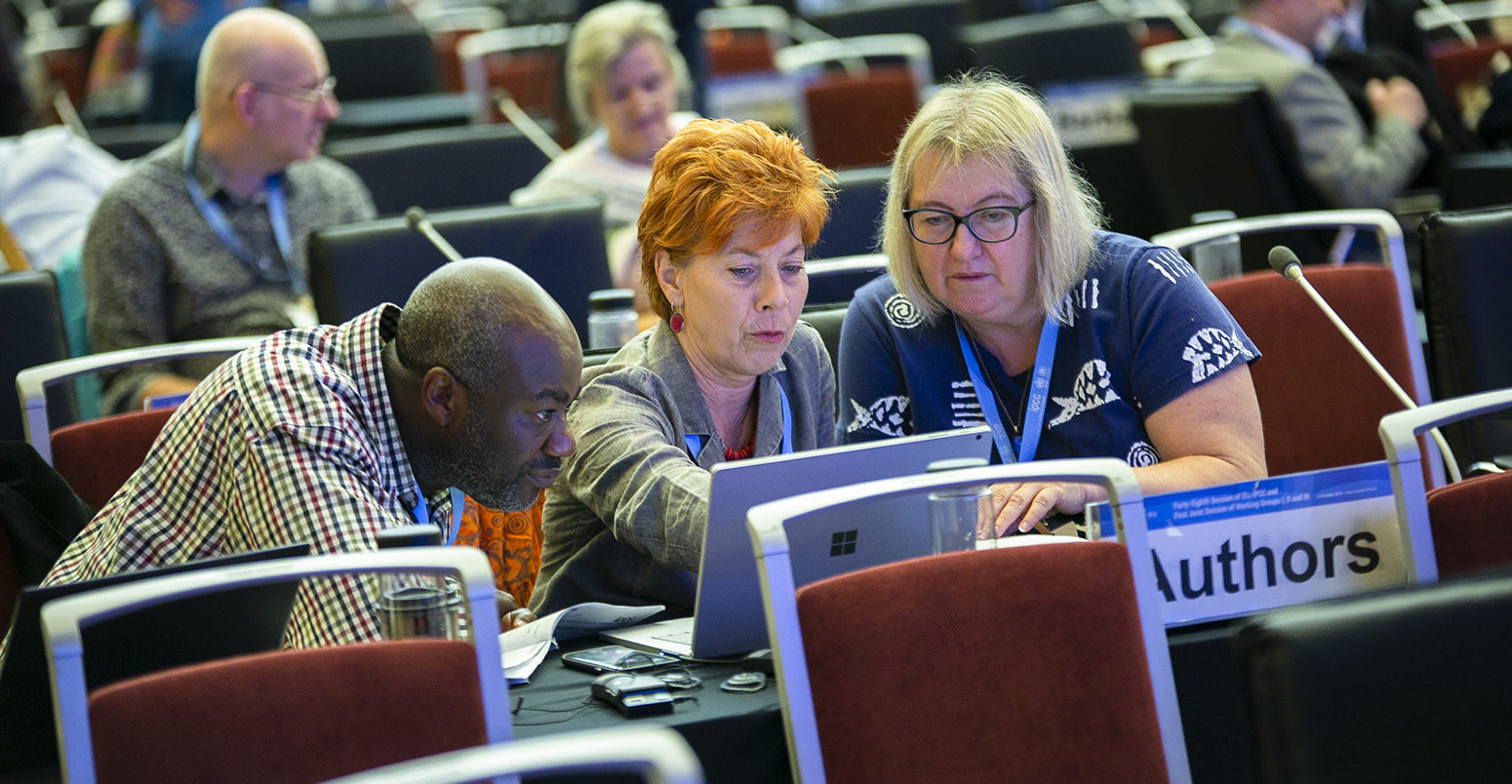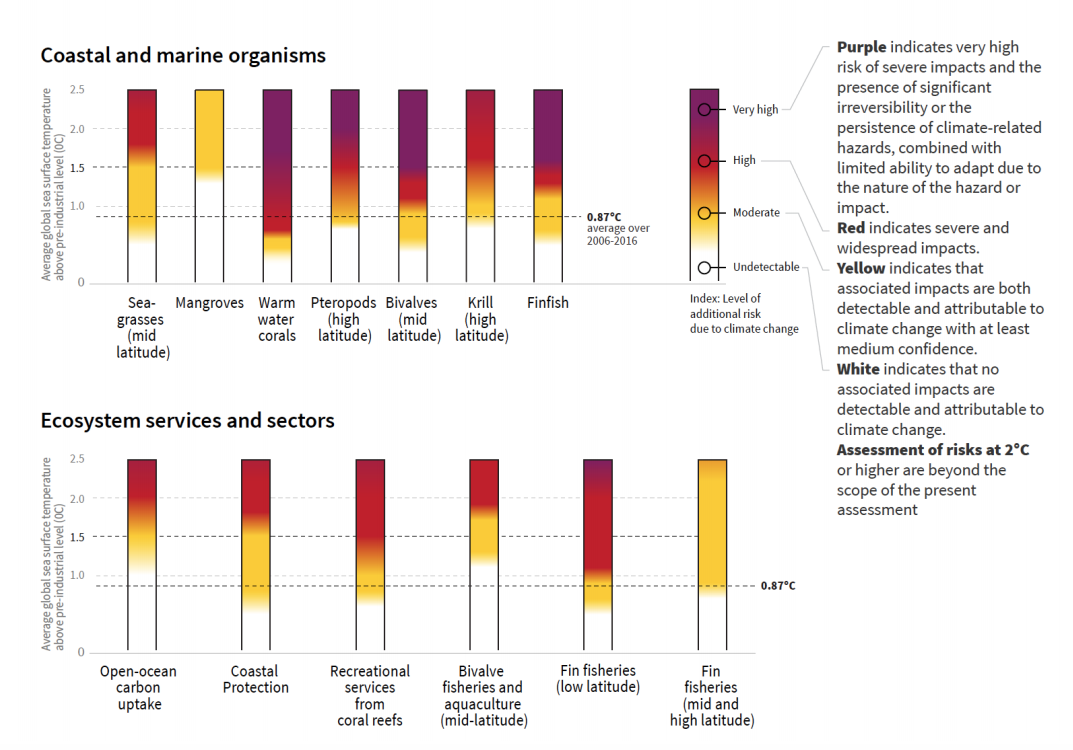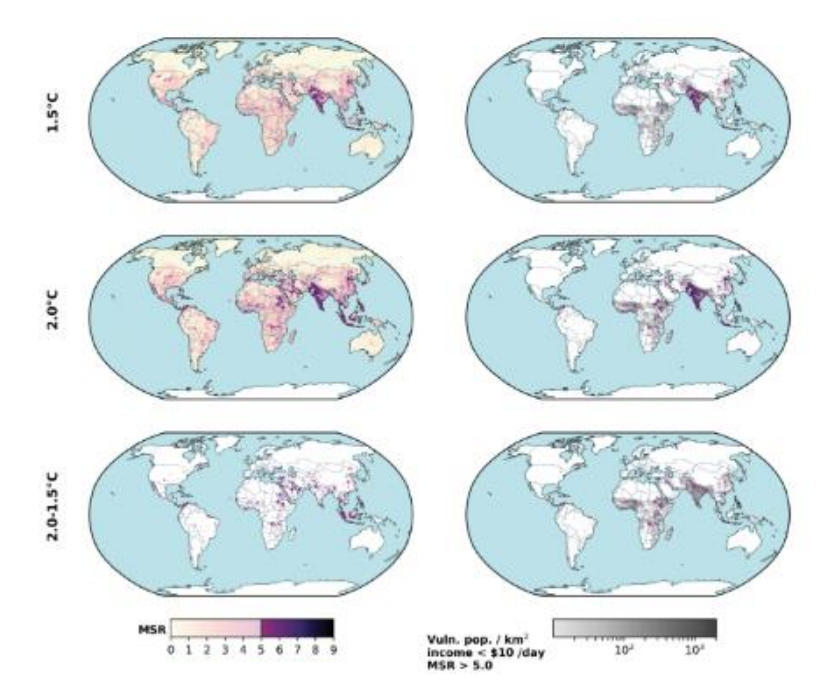
In-depth: Scientists discuss key findings of the IPCC’s special report on 1.5C
Carbon Brief Staff
10.10.18Carbon Brief Staff
10.10.2018 | 3:43pmEarlier this week, the Intergovernmental Panel on Climate Change (IPCC) published a special report on 1.5C.
It summarised what the latest science says about the impacts of such a rise in the global temperature, as well what the literature says about the ways to avoid it. (For all the details, see Carbon Brief’s in-depth Q&A.)
Here, Carbon Brief asks scientists from a range of disciplines to describe what they believe to be the report’s key findings.
- Dr Katharine Hayhoe, Texas Tech University
- Prof Gabi Hegerl, University of Edinburgh
- Prof Michael Oppenheimer, Princeton University
- Dr Jean-Pierre Gattuso, Laboratoire d’Océanographie de Villefranche
- Prof Govindasamy Bala, Indian Institute of Science
- Prof Terry Hughes, James Cook University
- Dr Friederike Otto, University of Oxford
- Prof Sabine Fuss, Mercator Research Institute on Global Commons and Climate Change
- Prof Helen Fricker, University of California San Diego
- Prof Kristie Ebi, University of Washington
- Dr Céline Guivarch, Centre International de Recherche sur l’Environnement et le Développement
- Dr Bill Hare, Climate Analytics
- Dr Massimo Tavoni, RFF-CMCC European Institute on Economics and the Environment
- Kathryn Brown, Committee on Climate Change
- Dr Emily Shuckburgh, British Antarctic Survey
- Prof Jan Minx, Mercator Research Institute on Global Commons and Climate Change
 Dr Katharine Hayhoe
Dr Katharine Hayhoe
Director
Climate Science Center, Texas Tech University
Until now, IPCC assessment reports have primarily quantified the impacts associated with a given pathway or scenario. However, climate targets aren’t expressed in terms of scenarios, but rather the stabilisation targets that were first laid out in the 1992 United Nations Framework Convention on Climate Change (UNFCCC). These targets are expressed in terms of carbon budgets, concentrations or global temperature change.
This has led to a mismatch between how climate science quantifies impacts versus how policy makers identify targets. But in order to set an effective target, we need to understand the impacts associated with a range of possible targets – not scenarios.
And that’s why this report is so important: because it lays out, in clear and unmistakable terms, the risks we face. Not under hypothetical scenarios that will never be realised, but under real-world targets of 1.5C of warming and above that are still within our grasp, if we heed this urgent warning.
 Prof Gabi Hegerl
Prof Gabi Hegerl
Professor of climate system science
University of Edinburgh
I really like that, in the report, the warming since pre-industrial times is clearly tied to human-induced warming. So the results of estimating the human contribution to observed warming now directly feed into a calculation of how much warming we already have caused and how much more warming we can add before we breach thresholds.
I am also really impressed with how the authors have pulled out the key impacts and differences between levels of warming, such as the much higher risk of ice-free Arctic summers under 2C compared to 1.5C.
The report also emphasises that we have seen significant changes in intensity and frequency of extreme events over periods of about 0.5C of global warming – both from looking at trends and from attributing individual events. Thus, changes we have already observed support the projection that half a degree more of warming will cause further noticeable and important changes.
 Prof Michael Oppenheimer
Prof Michael Oppenheimer
Professor of geosciences and international affairs
Princeton University
Policymakers should not assume that they can relax and wait for some mythical technology that’s going to suck CO2 out of the air to be technologically feasible and affordable. That may never happen. They have to get on solving the problem now by, first, providing all incentives possible for a transition as quickly as possible from fossil fuels to renewable energy and from sloppy economies to highly efficient economies.
And, number two, assuring that the possibility for the social transformation that has to accompany that – more compact living, less consumption of wasteful goods – can be done, that there are incentives in place, like a price on carbon, so that that people will want to do it. If all those elements come into place, we won’t need the mythical technologies.
 Dr Jean-Pierre Gattuso
Dr Jean-Pierre Gattuso
Senior research scientist
Laboratoire d’Océanographie de Villefranche
In 2015, colleagues and I assessed the risk of impacts resulting from elevated CO2, using three CO2 emissions scenarios, on key marine organisms and ecosystem services. This figure has been updated with knowledge accumulated since 2015 and expanded to non-marine systems. It is included in chapter 3 (figure 3.17, pdf) as well as in the summary for policymakers [shown below].

Summary of additional risks of impacts from ocean warming (and associated climate change factors such ocean acidification) for a range of ocean organisms, ecosystem and sectors at 1C, 1.5C and 2C warming of average sea surface temperature, relative to pre-industrial levels. Credit: IPCC (pdf)
This update for marine organisms and ecosystem services paints an even bleaker picture than the one we derived in 2015. Levels of risk have been increased for mangroves, warm-water corals and fin fisheries at low latitudes. I did not anticipate that risk levels will be adjusted upwards just three years after our initial assessment.
The chart illustrates that most systems would fare much better at 1.5C than at 2C. However, even 1.5C of warming would have dramatic consequences on several systems – demonstrating that we must prepare to manage the inevitable. How this could be done using ocean-based solutions has recently been assessed by a group of us.
 Prof Govindasamy Bala
Prof Govindasamy Bala
Professor
Center for Atmospheric and Oceanic Sciences, Indian Institute of Science
Achieving the CO2 emission reductions to limit the warming to 1.5C is simply not going to happen. Annual emissions have increased by an average of about 2% since Kyoto. If we reverse the course at the same 2% rate, which by itself is an uphill task, it would take about 35 years to cut the emissions by 50%. Hence, the 45% reduction by 2030 for the 1.5C goal, as suggested in the report [shown below], is nearly impossible. Unless a miracle happens, we are going to miss 1.5C or even 2C.

Source: Summary for policymakers, IPCC
The pathways to limit warming to 1.5C imply that we will continue to damage the environment in an even more determined way than before. To me, BECCS is like creating another large scale energy system to clean up the mess created by the fossil fuel-based energy system. Basically, the environmental damage could be doubled, if we take the carbon dioxide removal route.
 Prof Terry Hughes
Prof Terry Hughes
Director
Australian Research Council (ARC) Centre of Excellence for Coral Reef Studies, James Cook University
The world’s coral reefs – and the people who depend on them – are singled out by the IPCC as particularly vulnerable to anthropogenic climate change. Global warming of 1C has occurred since industrialisation began and current emissions will take us to 1.5C in another one to three decades.
Our research shows that, already, warming has caused enormous damage to coral reefs. For example, in 2016 and 2017, close to half of the corals on the Great Barrier Reef were bleached and killed as a result of record-breaking heatwaves. The IPCC report predicts that 2C will all but destroy the world’s coral reefs.
There is only one way to stop coral bleaching at a regional or global scale and that is to deal with the root cause, which is global warming. If we can reach the Paris Agreement target for 1.5C, we’ll still have coral reefs in the future – but they will look quite different from the reef of today or yesterday. Heat-sensitive species will dwindle and others will adapt.
Australia, as the country which has sole stewardship of the Great Barrier Reef, has a special responsibility to lead the world in the transition away from fossil fuels. Unfortunately, Australia’s emissions are still rising and not falling in line with commitments to the Paris Agreement.
 Dr Friederike Otto
Dr Friederike Otto
Acting director
Environmental Change Institute, University of Oxford
What this report has highlighted again is that, sea level rise aside, it is through extreme weather events that climate change manifests and, for the risks of high-impact extreme events, half a degree of additional warming makes a huge difference. For people who are already marginalised, this can be an existential difference.
Crucially, we are not doomed. We can limit global warming. How we do it, is a question of justice and equity.
 Prof Sabine Fuss
Prof Sabine Fuss
Head of the “sustainable resource management and global change” working group
Mercator Research Institute on Global Commons and Climate Change
The key finding in my area of research is the insight that all assessed 1.5C pathways, even the ones with enormous efforts to save emissions on the demand side, feature carbon removal – mostly on the order of magnitude of a few hundred billion tonnes until 2100.
Even though scaling up bioenergy with carbon capture and storage (BECCS) or afforestation to that level can result in concerns for sustainability, the report also contains an assessment of other methods to remove CO2 from the atmosphere. This shows that a portfolio of different methods deployed at smaller scales could enable carbon removal, while reducing risks for sustainability.
 Prof Helen Fricker
Prof Helen Fricker
Glaciologist
Scripps Institution of Oceanography, University of California San Diego
The results of the new report are not at all surprising to me. I have been studying the ice sheets for 25 years, nearly half my life. The changes we see there today are much larger than we thought would ever happen in our lifetimes.
It’s time to get serious about reducing carbon emissions and stop giving deniers a platform. They have confused the issue enough with their damaging and false rhetoric.
 Prof Kristie Ebi
Prof Kristie Ebi
Professor of global health and environmental health sciences
University of Washington
There are multiple key findings, including that climate change is already affecting people and their health – with the poor and disadvantaged most affected. Each additional unit of warming is projected to increase the burden of climate-sensitive health outcomes if additional adaptation and mitigation efforts are not implemented.
The projected risks of warming of 1.5C are higher than at present and will be higher still at 2C, with a few exceptions. Key areas where there was sufficient literature for at least medium confidence statements on increases in risk were: undernutrition, heat-related mortality, ozone-related mortality, malaria and dengue fever. Incorporating adaptation into model projections lowers the projected risks, underscoring the importance of investing in adaptation to increase the resilience of health systems.
Limiting warming to 1.5C is possible and would require unprecedented transitions. At the same time, many of the policies and technologies for reducing greenhouse gas emissions would benefit human health now. The size of those benefits are projected to offset most, if not all, of the costs of mitigation.
Communities and nations will not be adapting to issues separately – but to multiple risks simultaneously. Development choices will strongly influence the exposure and vulnerability of communities and regions to climate change.
Figure 3.18 from the report [shown below] illustrates multi-sector risk maps under different scenarios of climate and development. This reinforces the assessment in chapter five (pdf) of how addressing climate change would facilitate achievement of the sustainable development goals.

Distribution of “multi-sector risks” from climate change (left; low to high, white to dark purple) and vulnerable populations (right; low to high, white to black) under 1.5C, 2C and locations where 2C brings impacts not experienced at 1.5C. Source: IPCC
 Dr Céline Guivarch
Dr Céline Guivarch
Senior researcher
Centre International de Recherche sur l’Environnement et le Développement
The report conveys very strongly the message that global CO2 emissions have to reach net zero around 2050, in pathways compatible with the 1.5C target, and no longer later for 2C. This gives a very clear direction for actions at all scales and requires a dramatic change from current trends as global emissions are still rising.
 Dr Bill Hare
Dr Bill Hare
Director
Climate Analytics
Well, I think the central message is that 1.5C is already too much warming and we have to keep below that to give ourselves a liveable planet. And the second part of that is that what the scientists are showing is that 1.5C is really feasible. We can do it – we have the technology, we have the capacity. What’s needed are political decisions by governments to start moving forward all of those things that need to happen in order to get us on the 1.5C pathway.
 Dr Massimo Tavoni
Dr Massimo Tavoni
Director
RFF-CMCC European Institute on Economics and the Environment
Stabilising climate at low levels requires a mix of climate strategies. These include, first and foremost, mitigation, but also carbon engineering to a large extent – even in scenarios with low energy demand. Solar geoengineering has not been included in the mix due to lack of evidence.
 Kathryn Brown
Kathryn Brown
Head of adaptation
Committee on Climate Change
The stand-out message for me from the IPCC’s report is that, even with global warming of 2C, we can expect to see irreversible impacts on the natural environment, both here in the UK and around the world. The IPCC highlights coral reefs and Arctic ecosystems as being at particular risk.
The science behind these projections is well-established and also chimes with the committee’s own assessment of the key climate change risks facing the UK. Impacts at the global level will be felt here. With 2C of warming, the UK can expect increased flooding and coastal erosion, more heatwaves and water deficits, amongst others. Our risk assessment also highlights that, at 2C, a quarter of species in protected areas, and a quarter of internationally important blanket bog habitat will be under threat.
Action to tackle to these risks is not a “nice to have” – it’s absolutely essential.
 Dr Emily Shuckburgh
Dr Emily Shuckburgh
Deputy head, polar oceans
British Antarctic Survey
I think this statement is an important one to highlight in the 1.5C report:

Credit: IPCC (pdf)
The fact that sea levels will continue to rise even if temperatures are stabilised puts the hundreds of millions of people who live near the coast at long-term risk, even under some of the most optimistic scenarios. A glance at a map of the world’s growing megacities emphasises the threat. A recent report (pdf) from the Bank of England noted the risks posed by sea level rise and warned that both insured and uninsured losses related to such risks can affect the entire financial system from insurance firms to retail banks.
Rapidly achieving net-zero greenhouse gas emissions is essential to minimise sea level rise. A recent paper, for example, highlighted the importance of near-term mitigation action for limiting long-term sea-level rise risks. That study found that each five-year delay in near-term of CO2 emissions increases median year 2300 sea level rise estimate by about 0.2 metres and extreme sea level rise estimate by up to one metre.
It is thought that sustained temperature rise of the order 1.5C to 2C could threaten the vast ice sheets covering Greenland and West Antarctica. The loss of either of these ice sheets would lead to seas eventually rising by several metres, catastrophically transforming global coastlines.
A large UK-US research programme has recently been launched to study the Thwaites Glacier – a key component of the West Antarctic Ice Sheet. This single glacier is thought to be responsible for some 5% of sea level rise today, and understanding how it will respond to further atmospheric and oceanic warming is essential to provide robust assessments of future sea level rise. A good risk management strategy would place recognising and accounting for such low-probability but potentially catastrophic impacts as a high priority.
 Prof Jan Minx
Prof Jan Minx
Head of the “applied sustainability science” working group
Mercator Research Institute on Global Commons and Climate Change
To keep global warming below 1.5C, carbon dioxide removal (CDR) is a necessity. This is an unambiguous message coming from the new IPCC report. Even with the most ambitious emissions reduction program – one that appears far-fetched from political realities and from what countries are currently willing to do to avoid dangerous climate change – we will need to suck billions of tonnes of CO2 out of the atmosphere during the second half of the 21st century – permanently and verifiably. Hence, the big message is: we need to be good at both – emission reductions and CDR. If the two are contradictions as some people claim, we will not be able to move along the safest pathways for climate protection.
Accelerated learning on CDR is crucial. First, we need to explore the deployment of multiple CDR technologies in portfolios, because a variable set of technologies can help us to hedge the risks of scale-dependent side-effects. But we also need to learn about interaction effects as they compete for scarce bioenergy resources, land or storage space. Second, we need accelerated models of innovation. High-tech options like direct air capture or bioenergy with carbon capture and storage have the largest long-term potential for a secure and verifiable removal of CO2. However, they are still in early stages of demonstration or first commercial application.
It took 60 years since the first commercial use of solar PV in the Vanguard-1 satellite to the current state of widespread application of solar energy. If high-tech CDR options follow a similar timeline, this would be too late to stop global warming. Accelerating the process of innovation and technology diffusion is thus of major importance.
-
In-depth: Scientists discuss key findings of the IPCC’s special report on 1.5C

